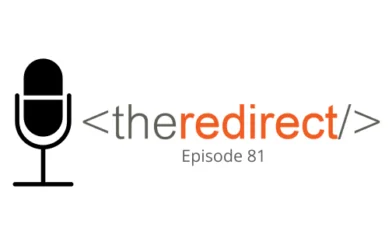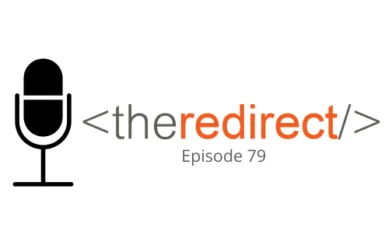Episode 20 / October 20, 2017
Listen now:
Thinking about starting your own podcast? Perhaps we can be of assistance. Our team’s first venture into podcasting began in May, and now we’ve made it to episode 20. We’ve learned a lot along the way, and reaching this milestone presents a great opportunity to share our experience and our tips for creating your first podcast.
Why Start a Podcast?
Podcast listenership has grown over time, with 24% of Americans saying they have listened to a podcast in the past month (read more from Edison Research). Considering the ease of accessibility to podcasts, and the relative ease to create them, podcasting is worth exploring as a channel for reaching your audience.
In full disclosure, our reason for starting a podcast is perhaps not the most conventional. Our team was already meeting once a week, in the spirit of our own professional development, to discuss what we’d learned from reading industry news. After a while, we decided we might as well record and share our conversation – if others find it helpful, that’s even better.
Podcasts are a great method for establishing thought leadership within an industry or niche. In our case, we’ve simply added a microphone to a weekly team discussion, but we do hope our podcast contributes to the greater good of the search industry and helps others who want to learn and stay informed.
Establish Ground Rules and Realistic Expectations
First, keep in mind that your audience may be very small, even nonexistent at first. Don’t get caught up with this; start your podcast with the expectation that nobody is going to listen to it. If you’re starting your podcast for the right reasons, the number of listeners shouldn’t matter. In our situation, we have information and insight we want to discuss, and the practice of podcasting is beneficial for us internally. We don’t expect to set the internet on fire; whether or not anyone else listens to it, we’ve met our expectations for a team knowledge share. That’s really our goal. When you’re getting started, create attainable goals for your unique situation.
Our podcast is clearly industry-specific, and there are times we can relate what we’re sharing to specific work that we’ve done. We’ve established a ground rule that it’s okay to make a general reference a project we’re working on, but we won’t mention client names or specific project details. We encourage other professionals to create similar ground rules when starting a business podcast.
Your podcast should have an overall theme that’s consistent across episodes and will keep your discussion on track. If you wander too far away from this focus, you’ll risk losing your listeners’ interest. Cater your podcast to your industry; educate, entertain, or discuss your products or service (if that’s your purpose).
Recording and Editing Your First Podcast
In most situations, there’s no need to be fancy or invest a lot of money when you’re just getting started. An external microphone is essential for podcasting; we use a Blue Snowball iCE. We record The Redirect Podcast in GarageBand, using the Narration Vocal input. The conference room where we record can make the raw audio a bit echoey, so we recommend making adjustments and dialing the audio in for your unique recording environment.
For better or worse, we record in one take and don’t spend a lot of effort on production value. This saves time and money, and helps us get the podcast online soon after recording. (To help stay on track for a one-take recording, we each come into the recording with notes or an outline to reference.)
Before releasing your podcast to the public, record a backlog of episodes to upload all at once. When you “go live” this way, listeners will have access to other episodes right away, rather than waiting for your next recording.
Podcast Distribution
RSS Distribution
To get your podcast distributed on iTunes and Stitcher, you’ll need to find a channel to develop an RSS feed. There are many applications out there for this, but we use SoundCloud and have found it to work well. We record in GarageBand, export to MP3, and upload to SoundCloud, which pushes the feed to iTunes and Stitcher. It’s possible to export directly from GarageBand to syndication sources, but we prefer to go the manual route. We also write titles, descriptions, and tags on SoundCloud that show each episode’s topics of discussion. These details will also transfer to the other channels.
Podcasting for Content Marketing
Podcasting can feed your content marketing efforts in many ways. Think about how you can share the podcast beyond merely distributing the audio.
Create a blog post on your website to share show notes for every episode. In our show notes, we link to the articles we found of value to our discussion, and add our reactions, analysis, and key takeaways. We also embed the SoundCloud player into each post so readers have the option of listening while on our site.
Another option for show notes is to share transcriptions of the podcasts. This would involve some financial and/or time investment, but it’s a good way to capture all the elements of the conversation.
When the show notes are live for each episode, link to the blog post in the episode’s description to direct listeners to your website. (In our case, we add the link in the episode description on SoundCloud).
Share links to your podcast on your social media channels. After producing a few podcasts with show notes live on your site, experiment with sharing links either to your syndication service (SoundCloud) or the blog post to find which method people engage with more.
SEO Benefits of Podcasting
Though our podcast is still relatively young, we do see even our most recent podcast blog posts as being indexed and bringing in traffic from organic search. To make this happen for your podcast, use the basics of on-page SEO to describe each episode in your titles, descriptions, and headers for your show notes.
Right now, we notice the majority of listens are happening in-app rather than through the embedded player in our blog posts. Still, it’s encouraging to see visitors are engaging with the show notes.
Get Started!
In summary: Have a clear purpose for your podcast, secure the right tools, have a plan for distribution, and track engagement over time. You don’t have to go overboard when recording your first podcast; just put something out there and see what happens. We’ve enjoyed the experience of podcasting so far, and we hope to have more insight to share after 20 more episodes. Good luck, and happy podcasting!
Thanks for tuning in! To catch future episodes of The Redirect Podcast, subscribe on Soundcloud, iTunes, or Stitcher.




